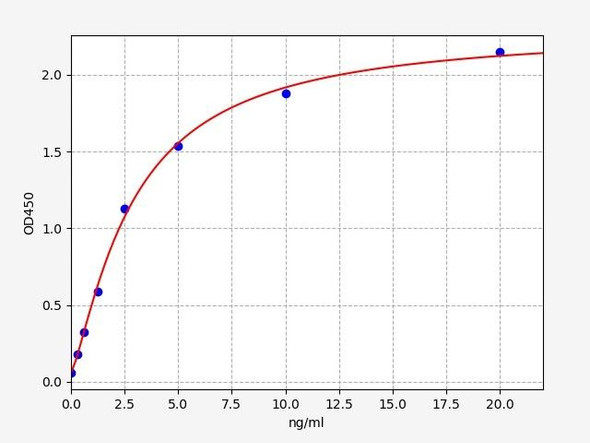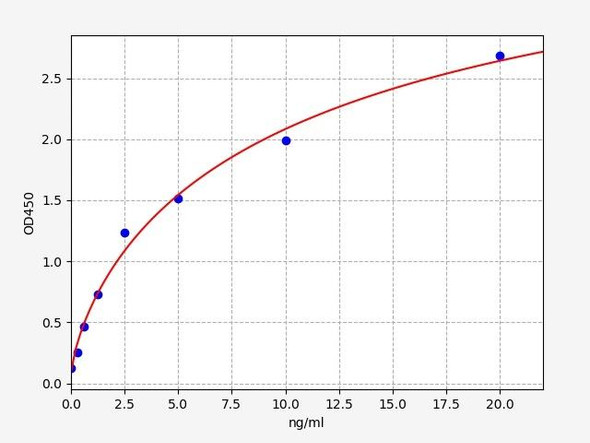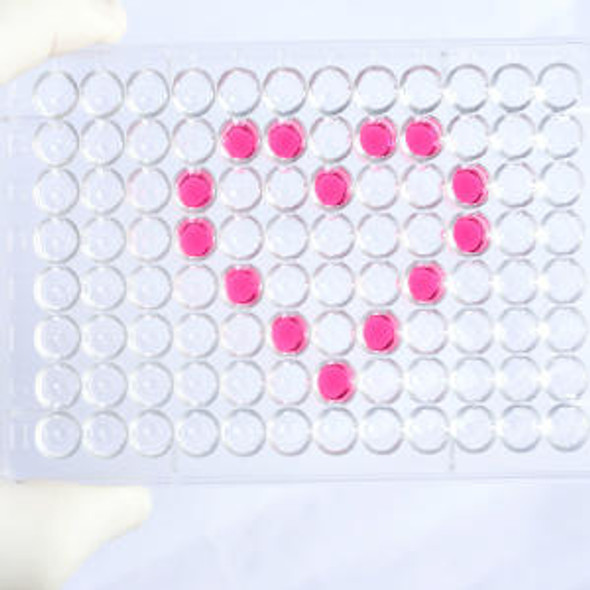Human GP4 / CD36 ELISA Kit
- SKU:
- HUFI00075
- Product Type:
- ELISA Kit
- Size:
- 96 Assays
- Uniprot:
- P16671
- Sensitivity:
- 0.094ng/ml
- Range:
- 0.156-10ng/ml
- ELISA Type:
- Sandwich ELISA, Double Antibody
- Synonyms:
- CD36, GP4, Platelet Membrane Glycoprotein IV
- Reactivity:
- Human
Description
Human GP4 / CD36 ELISA Kit
Platelet glycoprotein 4 (GPP4) or CD36 is a protein that in humans is encoded by the GP4 gene. The GP4 protein is a member of the platelet glycoprotein family and it is found on the surface of platelets as well as other cells such as megakaryocytes. Platelet glycoprotein 4 is is a type of glycoprotein that plays a key role in the immune system. It functions in the recognition and adhesion of platelets to damaged tissues. It is used as a marker for breast cancer and leukemia. The Assay Genie Human GP4/CD36 ELISA kit is a highly sensitive assay for the quantitative measurement of GP4 in serum, blood, plasma, cell culture supernatant, and tissue samples.
| Product Name: | Human GP4 / CD36 ELISA Kit |
| Product Code: | HUFI00075 |
| Size: | 96 Assays |
| Alias: | CD36, GP4, Platelet Membrane Glycoprotein IV |
| Detection method: | Sandwich ELISA, Double Antibody |
| Application: | This immunoassay kit allows for the in vitro quantitative determination of Human GP4 concentrations in serum plasma and other biological fluids. |
| Sensitivity: | 0.094ng/ml |
| Range: | 0.156-10ng/ml |
| Storage: | 4°C for 6 months |
| Note: | For Research Use Only |
| Recovery: | Matrices listed below were spiked with certain level of Human GP4 and the recovery rates were calculated by comparing the measured value to the expected amount of Human GP4 in samples. | ||||||||||||||||
| |||||||||||||||||
| Linearity: | The linearity of the kit was assayed by testing samples spiked with appropriate concentration of Human GP4 and their serial dilutions. The results were demonstrated by the percentage of calculated concentration to the expected. | ||||||||||||||||
| |||||||||||||||||
| CV(%): | Intra-Assay: CV<8% Inter-Assay: CV<10% |
| Component | Quantity | Storage |
| ELISA Microplate (Dismountable) | 8×12 strips | 4°C for 6 months |
| Lyophilized Standard | 2 | 4°C/-20°C |
| Sample/Standard Dilution Buffer | 20ml | 4°C |
| Biotin-labeled Antibody(Concentrated) | 120ul | 4°C (Protect from light) |
| Antibody Dilution Buffer | 10ml | 4°C |
| HRP-Streptavidin Conjugate(SABC) | 120ul | 4°C (Protect from light) |
| SABC Dilution Buffer | 10ml | 4°C |
| TMB Substrate | 10ml | 4°C (Protect from light) |
| Stop Solution | 10ml | 4°C |
| Wash Buffer(25X) | 30ml | 4°C |
| Plate Sealer | 5 | - |
Other materials and equipment required:
- Microplate reader with 450 nm wavelength filter
- Multichannel Pipette, Pipette, microcentrifuge tubes and disposable pipette tips
- Incubator
- Deionized or distilled water
- Absorbent paper
- Buffer resevoir
| Uniprot | P16671 |
| UniProt Protein Function: | CD36: Seems to have numerous potential physiological functions. Binds to collagen, thrombospondin, anionic phospholipids and oxidized LDL. May function as a cell adhesion molecule. Directly mediates cytoadherence of Plasmodium falciparum parasitized erythrocytes. Binds long chain fatty acids and may function in the transport and/or as a regulator of fatty acid transport. Receptor for thombospondins, THBS1 AND THBS2, mediating their antiangiogenic effects. Defects in CD36 are the cause of platelet glycoprotein IV deficiency (PG4D)[MIM:608404]; also known as CD36 deficiency. Platelet glycoprotein IV deficiency can be divided into 2 subgroups. The type I phenotype is characterized by platelets and monocytes/macrophages exhibiting complete CD36 deficiency. The type II phenotype lacks the surface expression of CD36 in platelets, but expression in monocytes/macrophages is near normal. Genetic variations in CD36 are associated with susceptibility to coronary heart disease type 7 (CHDS7). Belongs to the CD36 family. |
| UniProt Protein Details: | Protein type:Membrane protein, multi-pass; Membrane protein, integral; Cell adhesion Chromosomal Location of Human Ortholog: 7q11.2 Cellular Component: Golgi apparatus; extracellular space; platelet alpha granule membrane; cell surface; membrane; integral to plasma membrane; plasma membrane; phagocytic vesicle; lipid raft; external side of plasma membrane Molecular Function:low-density lipoprotein receptor activity; transforming growth factor beta binding; low-density lipoprotein binding; lipid binding; high-density lipoprotein binding Biological Process: positive regulation of blood coagulation; cGMP-mediated signaling; positive regulation of interleukin-12 production; phagocytosis, recognition; negative regulation of transcription from RNA polymerase II promoter; cellular lipid metabolic process; negative regulation of transcription factor import into nucleus; low density lipoprotein mediated signaling; sequestering of lipid; antigen processing and presentation of peptide antigen via MHC class I; cell surface receptor linked signal transduction; platelet degranulation; positive regulation of MAPKKK cascade; antigen processing and presentation of exogenous peptide antigen via MHC class I; positive regulation of cell-matrix adhesion; cell adhesion; toll-like receptor 4 signaling pathway; receptor-mediated endocytosis; platelet activation; positive regulation of I-kappaB kinase/NF-kappaB cascade; cholesterol transport; positive regulation of interleukin-6 production; antigen processing and presentation of exogenous peptide antigen via MHC class I, TAP-dependent; positive regulation of tumor necrosis factor production; toll-like receptor 2 signaling pathway; MyD88-dependent toll-like receptor signaling pathway; defense response to Gram-positive bacterium; positive regulation of peptidyl-tyrosine phosphorylation; lipoprotein transport; toll-like receptor signaling pathway; innate immune response; lipid metabolic process; blood coagulation; positive regulation of phagocytosis, engulfment; plasma membrane long-chain fatty acid transport; nitric oxide mediated signal transduction; apoptotic cell clearance Disease: Platelet Glycoprotein Iv Deficiency; Coronary Heart Disease, Susceptibility To, 7; Malaria, Susceptibility To |
| NCBI Summary: | The protein encoded by this gene is the fourth major glycoprotein of the platelet surface and serves as a receptor for thrombospondin in platelets and various cell lines. Since thrombospondins are widely distributed proteins involved in a variety of adhesive processes, this protein may have important functions as a cell adhesion molecule. It binds to collagen, thrombospondin, anionic phospholipids and oxidized LDL. It directly mediates cytoadherence of Plasmodium falciparum parasitized erythrocytes and it binds long chain fatty acids and may function in the transport and/or as a regulator of fatty acid transport. Mutations in this gene cause platelet glycoprotein deficiency. Multiple alternatively spliced transcript variants have been found for this gene. [provided by RefSeq, Feb 2014] |
| UniProt Code: | P16671 |
| NCBI GenInfo Identifier: | 115982 |
| NCBI Gene ID: | 948 |
| NCBI Accession: | P16671.2 |
| UniProt Secondary Accession: | P16671,Q13966, Q16093, Q8TCV7, Q9BPZ8, Q9BQC2, Q9BZM8 Q9BZN3, D9IX66, D9IX67, D9IX68, D9IX69, |
| UniProt Related Accession: | P16671 |
| Molecular Weight: | 472 |
| NCBI Full Name: | Platelet glycoprotein 4 |
| NCBI Synonym Full Names: | CD36 molecule (thrombospondin receptor) |
| NCBI Official Symbol: | CD36 |
| NCBI Official Synonym Symbols: | FAT; GP4; GP3B; GPIV; CHDS7; PASIV; SCARB3; BDPLT10 |
| NCBI Protein Information: | platelet glycoprotein 4; GPIIIB; PAS IV; PAS-4 protein; glycoprotein IIIb; cluster determinant 36; fatty acid translocase; platelet glycoprotein IV; scavenger receptor class B, member 3; leukocyte differentiation antigen CD36; CD36 antigen (collagen type |
| UniProt Protein Name: | Platelet glycoprotein 4 |
| UniProt Synonym Protein Names: | Fatty acid translocase; FAT; Glycoprotein IIIb; GPIIIB; Leukocyte differentiation antigen CD36; PAS IV; PAS-4; Platelet collagen receptor; Platelet glycoprotein IV; GPIV; Thrombospondin receptor; CD_antigen: CD36 |
| Protein Family: | Fat body protein |
| UniProt Gene Name: | CD36 |
| UniProt Entry Name: | CD36_HUMAN |
*Note: Protocols are specific to each batch/lot. For the correct instructions please follow the protocol included in your kit.
Before adding to wells, equilibrate the SABC working solution and TMB substrate for at least 30 min at 37°C. When diluting samples and reagents, they must be mixed completely and evenly. It is recommended to plot a standard curve for each test.
| Step | Protocol |
| 1. | Set standard, test sample and control (zero) wells on the pre-coated plate respectively, and then, record their positions. It is recommended to measure each standard and sample in duplicate. Wash plate 2 times before adding standard, sample and control (zero) wells! |
| 2. | Aliquot 0.1ml standard solutions into the standard wells. |
| 3. | Add 0.1 ml of Sample / Standard dilution buffer into the control (zero) well. |
| 4. | Add 0.1 ml of properly diluted sample ( Human serum, plasma, tissue homogenates and other biological fluids.) into test sample wells. |
| 5. | Seal the plate with a cover and incubate at 37 °C for 90 min. |
| 6. | Remove the cover and discard the plate content, clap the plate on the absorbent filter papers or other absorbent material. Do NOT let the wells completely dry at any time. Wash plate X2. |
| 7. | Add 0.1 ml of Biotin- detection antibody working solution into the above wells (standard, test sample & zero wells). Add the solution at the bottom of each well without touching the side wall. |
| 8. | Seal the plate with a cover and incubate at 37°C for 60 min. |
| 9. | Remove the cover, and wash plate 3 times with Wash buffer. Let wash buffer rest in wells for 1 min between each wash. |
| 10. | Add 0.1 ml of SABC working solution into each well, cover the plate and incubate at 37°C for 30 min. |
| 11. | Remove the cover and wash plate 5 times with Wash buffer, and each time let the wash buffer stay in the wells for 1-2 min. |
| 12. | Add 90 µl of TMB substrate into each well, cover the plate and incubate at 37°C in dark within 10-20 min. (Note: This incubation time is for reference use only, the optimal time should be determined by end user.) And the shades of blue can be seen in the first 3-4 wells (with most concentrated standard solutions), the other wells show no obvious color. |
| 13. | Add 50 µl of Stop solution into each well and mix thoroughly. The color changes into yellow immediately. |
| 14. | Read the O.D. absorbance at 450 nm in a microplate reader immediately after adding the stop solution. |
When carrying out an ELISA assay it is important to prepare your samples in order to achieve the best possible results. Below we have a list of procedures for the preparation of samples for different sample types.
| Sample Type | Protocol |
| Serum | If using serum separator tubes, allow samples to clot for 30 minutes at room temperature. Centrifuge for 10 minutes at 1,000x g. Collect the serum fraction and assay promptly or aliquot and store the samples at -80°C. Avoid multiple freeze-thaw cycles. If serum separator tubes are not being used, allow samples to clot overnight at 2-8°C. Centrifuge for 10 minutes at 1,000x g. Remove serum and assay promptly or aliquot and store the samples at -80°C. Avoid multiple freeze-thaw cycles. |
| Plasma | Collect plasma using EDTA or heparin as an anticoagulant. Centrifuge samples at 4°C for 15 mins at 1000 × g within 30 mins of collection. Collect the plasma fraction and assay promptly or aliquot and store the samples at -80°C. Avoid multiple freeze-thaw cycles. Note: Over haemolysed samples are not suitable for use with this kit. |
| Urine & Cerebrospinal Fluid | Collect the urine (mid-stream) in a sterile container, centrifuge for 20 mins at 2000-3000 rpm. Remove supernatant and assay immediately. If any precipitation is detected, repeat the centrifugation step. A similar protocol can be used for cerebrospinal fluid. |
| Cell culture supernatant | Collect the cell culture media by pipette, followed by centrifugation at 4°C for 20 mins at 1500 rpm. Collect the clear supernatant and assay immediately. |
| Cell lysates | Solubilize cells in lysis buffer and allow to sit on ice for 30 minutes. Centrifuge tubes at 14,000 x g for 5 minutes to remove insoluble material. Aliquot the supernatant into a new tube and discard the remaining whole cell extract. Quantify total protein concentration using a total protein assay. Assay immediately or aliquot and store at ≤ -20 °C. |
| Tissue homogenates | The preparation of tissue homogenates will vary depending upon tissue type. Rinse tissue with 1X PBS to remove excess blood & homogenize in 20ml of 1X PBS (including protease inhibitors) and store overnight at ≤ -20°C. Two freeze-thaw cycles are required to break the cell membranes. To further disrupt the cell membranes you can sonicate the samples. Centrifuge homogenates for 5 mins at 5000xg. Remove the supernatant and assay immediately or aliquot and store at -20°C or -80°C. |
| Tissue lysates | Rinse tissue with PBS, cut into 1-2 mm pieces, and homogenize with a tissue homogenizer in PBS. Add an equal volume of RIPA buffer containing protease inhibitors and lyse tissues at room temperature for 30 minutes with gentle agitation. Centrifuge to remove debris. Quantify total protein concentration using a total protein assay. Assay immediately or aliquot and store at ≤ -20 °C. |
| Breast Milk | Collect milk samples and centrifuge at 10,000 x g for 60 min at 4°C. Aliquot the supernatant and assay. For long term use, store samples at -80°C. Minimize freeze/thaw cycles. |










